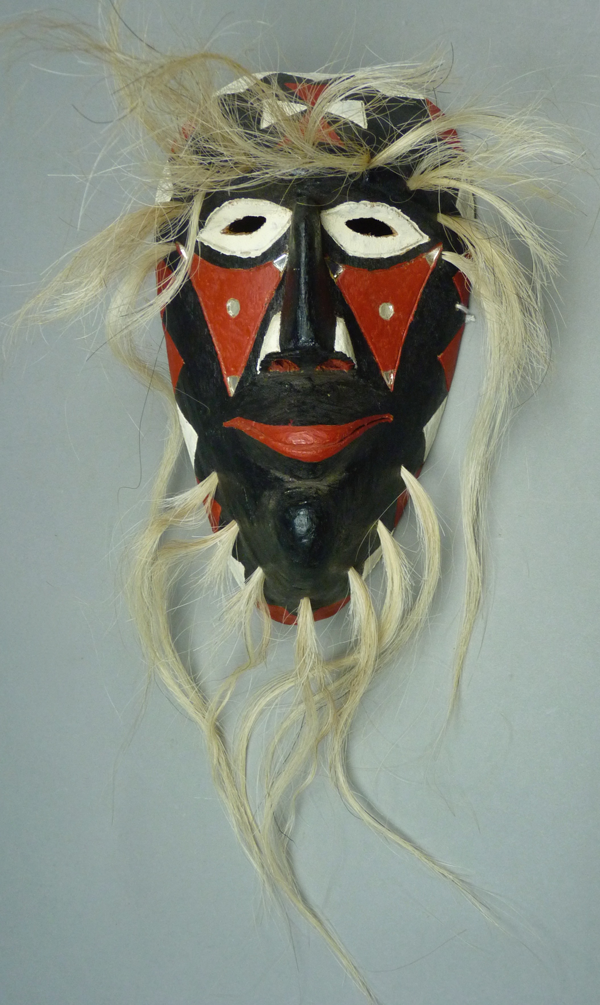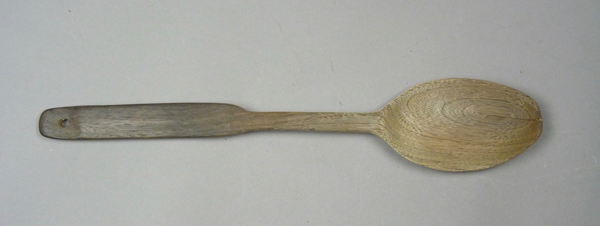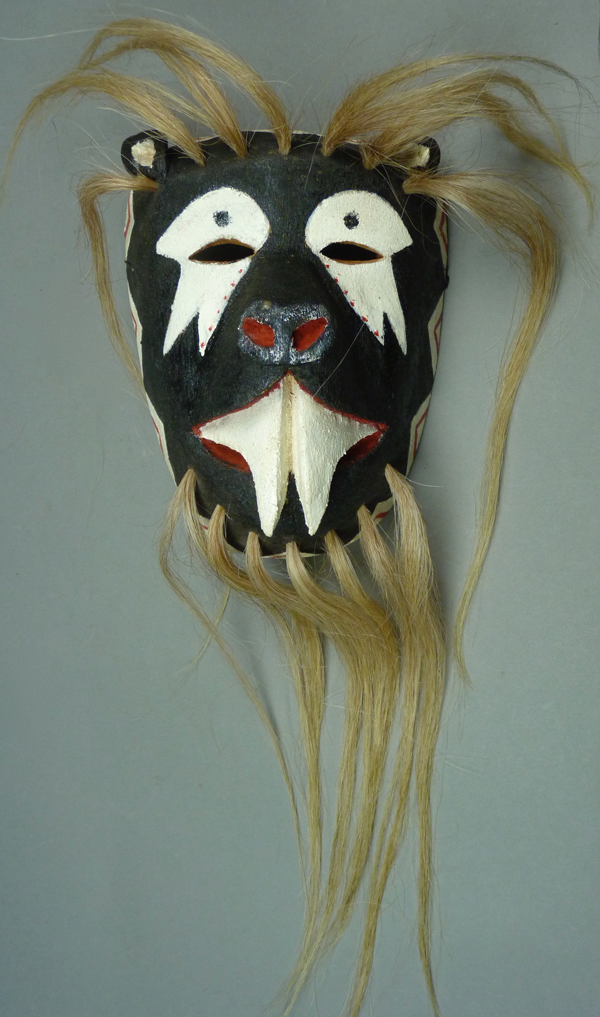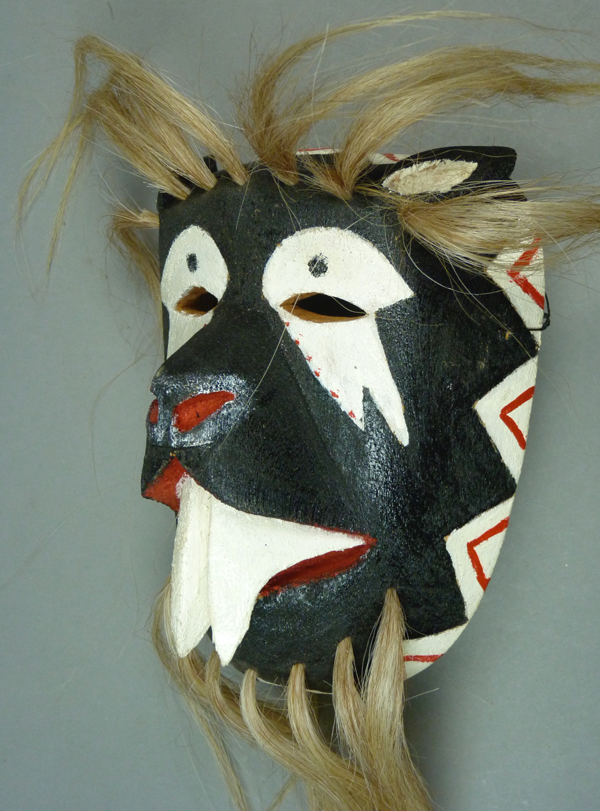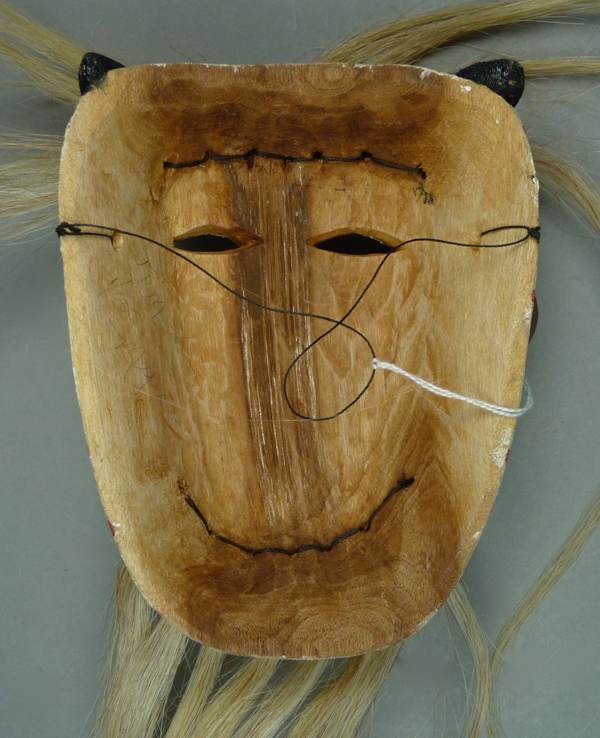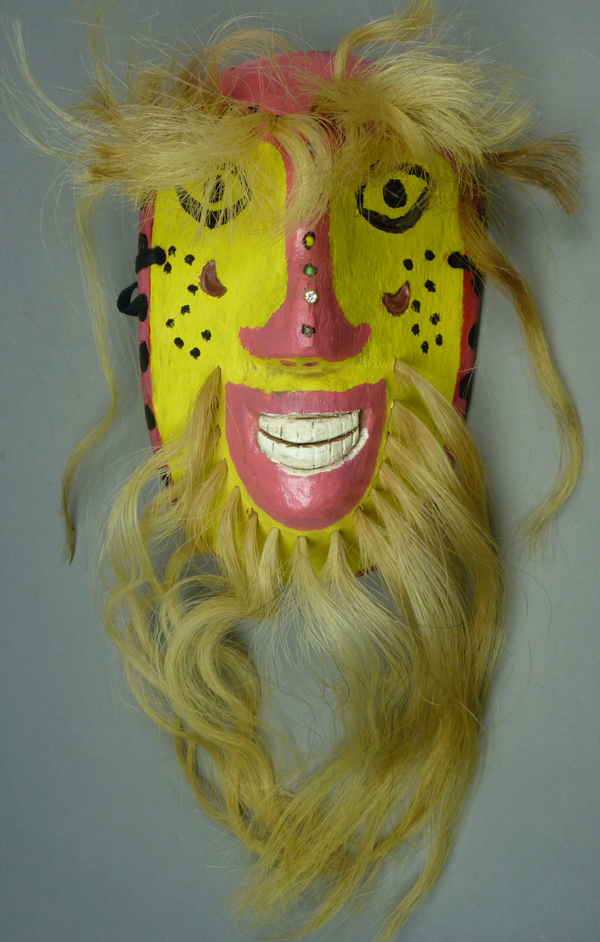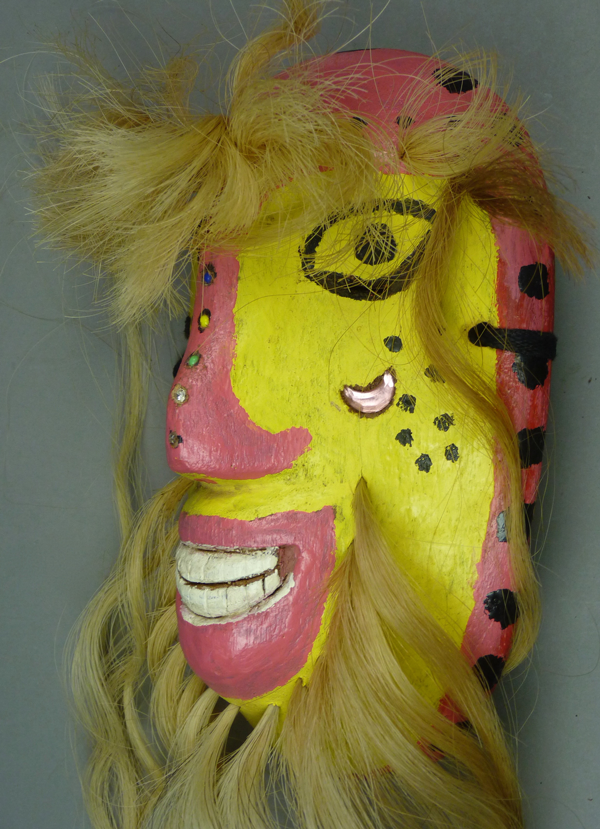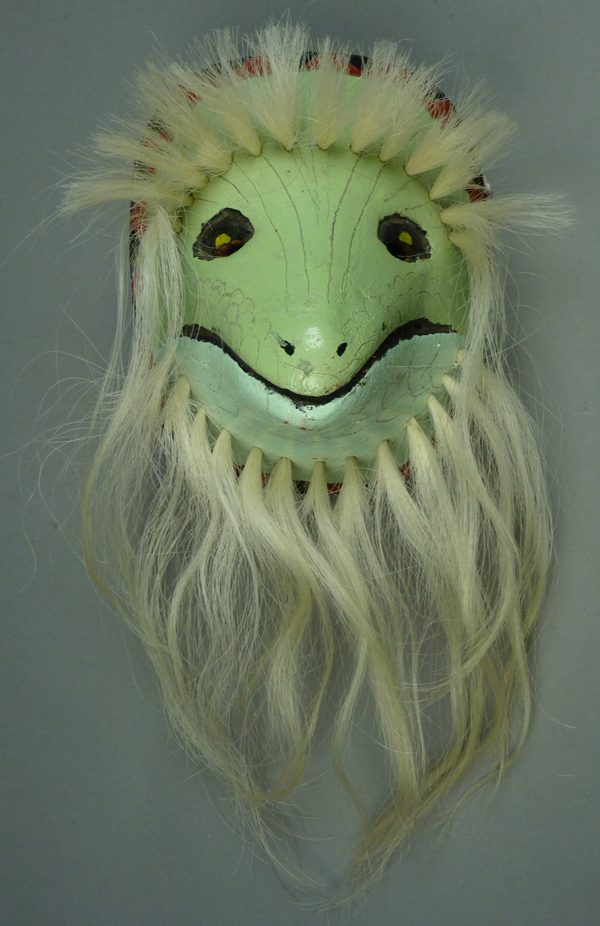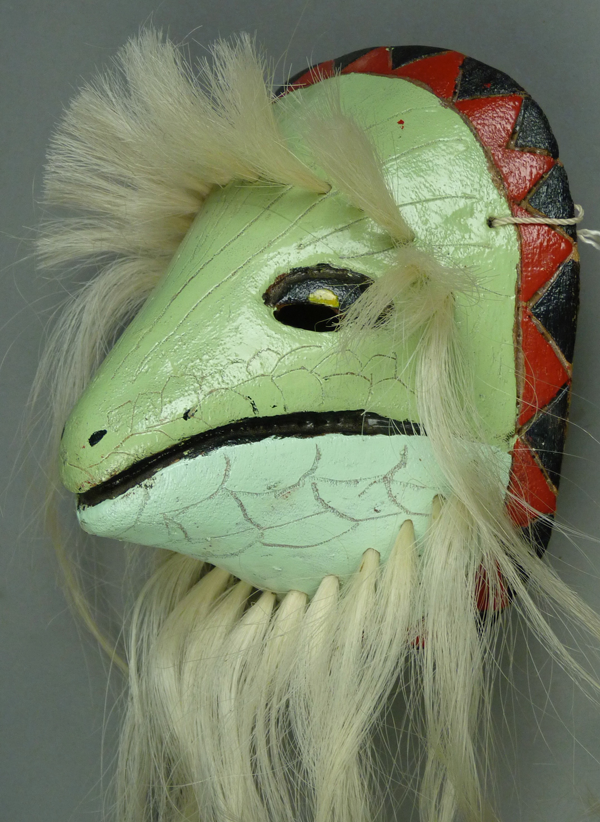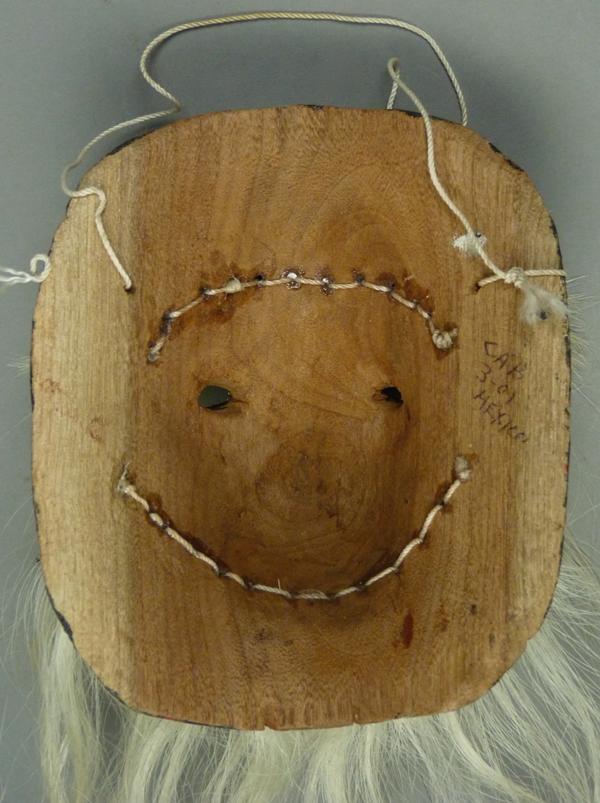Today I want to introduce you to Barney T. Burns and Mahina Drees Burns, an interesting and important couple on several counts. I am uncertain how to begin, so I will simply plunge into the middle of the story and then expand from there.
Barney and Mahina collected and distributed masks made by Mexican Indians, writing in pencil on the back of each mask the initials of the carver and the month and year of collection. In a sea of undocumented masks, those that passed through their hands are a welcome gift! In recent posts you have already seen masks by Antonio Bacasewa that had this documentation. Today my purpose is to visually transport you back to Tucson in the 1990s, when an assortment of interesting made for sale masks was available as a consequence of these traders’ efforts. Here is one of those masks, which I purchased directly from Barney Burns and Mahina Drees in June, 1999. I will revisit this one in greater detail in two weeks.
The carver of this mask, Rodrigo Rodríguez Muñoz, provided traditional style masks to Yaqui Pascola dancers in his community and his masks were popular there. In response to the opportunity to sell to American tourists and collectors, he maintained much of his usual style, but experimented with brighter paint, enhanced decorative elements, and occasional novel designs. Also, although his made for sale masks had an appropriate form, Rodrigo did not carve them to the standard of masks that he made for dancing. This is an excellent example of his made for sale carvings—a handsome mask that combines tradition and glitz in an attractive blend.
Rhinestones, glitter, and interesting paint (such as “silver” or aluminum paint) had also become popular in Mayo communities, particularly on the masks used in traditional fiestas. But among the Yaquis such embellishments seem to have been adopted less by traditional performers. Plastic jewels and bits of mirror glass are the main additions to this first mask. Otherwise it illustrates a general trend for the made for sale masks to have less impressive brows and beards (fewer hair bundles and less hair per bundle). However, as I pointed out and illustrated in recent posts, Antonio Bacasewa did NOT subscribe to these trends.
Barney Burns was born in California, but moved with his family to Arizona as a child. In 1969, at the age of 24, he established his trading company, Unknown Mexico, a wholesale importer of Indian crafts from Northern Mexico. Subsequently he trained as an anthropologist at the University of Arizona, and for a time he worked in that field. He married Mahina Drees in 1986. She had trained as a secondary education teacher, but after moving to San Francisco in the colorful era of the 1960s and 70s, she spent nearly a decade in the theatre arts, and even took graduate courses in that field. She has written over 100 songs, and in the past she performed regularly as a singer, accompanying herself on the guitar. By 1983 Barney and Mahina had met, as they were co-founders in that year of Native Seeds/Search, a subject which I will return to shortly.
Following their marriage in 1986, Mahina joined Barney as an Indian trader. They were agents who bought craft items from the Indians of northern Mexico and sold them to Museum shops, Indian arts stores, and folk art dealers in the United States. Among other reasons, they carried on this trade because they were genuinely interested in the Indians; they wanted to provide these craftsmen with access to broader markets for their goods. The craftsmen, who were primarily farmers who made crafts in their free time, were definitely interested in this, as such trade gave them access to cash, something that was otherwise rare in their subsistence economy. The market for such crafts in the United States was palpable, but not strong enough to support high prices. Our traders had to work to limited price points, as they were selling these goods wholesale to American merchants. This arrangement was responsible for the ready availability in Tucson and elsewhere of inexpensive masks and other crafts from producers living in Yaqui, Mayo, Mountain Pima, Warihio, and Tarahumara communities in northern Mexico. Such crafts included wooden bowls and kitchen utensils, pottery, textiles, musical instruments such as flutes and drums, paintings, and other items. This was a two way street, as Barney and Mahina had a policy of bringing necessary supplies to their crafts people, such as paint, as well as donated clothing, which they collected in Tucson.
In the context of their trading, Barney and Mahina became aware that the Indians had an unexpected concern—they were having difficulty obtaining seeds for their traditional crops. In their travels, these traders had access to a remarkable variety of traditional seed stocks, so they began to systematically collect, cultivate, and store these. In 1983, with Karen Reichhardt and Gary Paul Nabhan (a naturalist whose work I recommend, e.g. Counting Sheep: 20 Ways of Seeing Desert Bighorn), they established a non profit foundation in Tucson—Native Seeds/Search—for the purpose of preserving and sharing this bounty of wild and native seeds for future generations of Indians as well as American farmers and gardeners. Mahina remains on the governing board of Native Seeds/Search to this day. I have repeatedly visited the Native Seeds/Search store in Tucson to buy Yoeme Pascola masks and wooden cooking implements made by other Indians. Here is the graceful wooden spoon from that store that I have used daily for at least 10 years, carved by a Mayo Indian in Sonora. It is made from catclaw (Acacia wood). It is 12½ inches long.
The next mask was carved by Jesús Rodríguez Muñoz, the brother of Rodrigo Rodríguez Muñoz. This would appear to represent a bat.
The made for sale masks of Jesús, as well as those of Camilo Álvarez Buitimea, sometimes appear to represent the animals and birds of the Sea Ania (the flower world), which is one of the Yoeme parallel realms. This is the home of the Deer spirit, a presence that is portrayed by the Deer dancer. Therefore such animal masks may be less superficial than they seem, even though they are not usually worn by Pascola dancers (however they have sometimes been worn in recent decades). Bats can be thought of as denizens of another Yaqui realm, the Tuku Ania (the night world).
This bat has a particularly dramatic appearance, with these prominent teeth and the jagged triangles under the eyes. Also note the tiny ears.
It is interesting to see what is ordinarily a small face portrayed so large.
This mask is 7 inches tall, 5¼ inches wide, and 3 inches deep.
The inscription by Barney and Mahina on the left side of the rim states “JRM, 1/05, Mexico.” The back of this this mask is generously cut, as if it was intended for use by a dancer.
The third mask was carved by Silvario A. Sol. Due to the colors, my response to this mask was love at first sight! I have other masks by Silvario of the same form, but painted more traditionally, which I will show you in a future post. This mask underscores the freedom that the made for sale market provided to these traditional carvers, who were ordinarily constrained by cultural traditions and related expectations. The empowering of the made for sale market by Barney and Mahina led some artists to participate in what was essentially a new “school” of folk painters and carvers.
Some of these plastic jewels were provided to the carvers by Barney and Mahina.
The hair on this mask is marginal, but far better than what we find on some made for sale masks from other parts of Mexico.
This mask is 9½ inches tall, 6 inches wide, and 2¾ inches deep.
“SAS 8/00” is written on the back. Here is a nicely finished back with tiny openings for vision and no staining from use.
The last mask in this survey of the made for sale masks is the most interesting to me, as it reflects this carver’s interest in creating non-traditional mask designs that appear to portray the animals of the Sea Ania, the Flower World that is considered sacred by the Yoemem (the Yaqui People). The carver was Camilo Álvarez Buitimea of Potam, Sonora (CAB). We see a mask with a realistic face of a lizard. In future posts I will have many more of this carver’s masks to show you.
Isn’t this a terrific work of art! Furthermore it has been made to a high standard.
When I purchased this mask, a decade ago, I had no idea how much I would come to like it.
This mask is 6½ inches tall, 5½ inches wide, and 3½ inches deep.
Barney and Mahina purchased this mask from the carver in March, 2001. His masks are very comfortable to wear.
Next week I will tell you more about Barney Burns and Mahina Drees. Briefly,during all those years when they were engaged in Indian trade, they were also collecting danced masks for their own private collection, a “hoard” which I regard as an invaluable time capsule of the Yoeme culture in the decades surrounding the turn of the 21st century. I will draw from their danced collection to demonstrate the work of many interesting carvers, including the four whose made for sale masks appear in today’s post.

